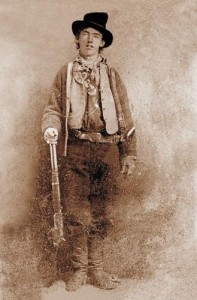The date: July 15th through 19th, 1878. The place: Lincoln County , New Mexico
Billy the Kid, one of the Lincoln County Regulators
The four day fight had its roots in the Lincoln County war, an ongoing conflict between an established store owner and his partner, Lawrence Murphy & James Dolan, and John Tunstall & Alexander McSween, newcomers who owned a competing store, over who controlled the sale of dry goods in Lincoln County , New Mexico
The climax of the war was the Battle of Lincoln. On the 15th of July, McSween gathered the Regulators in town. Nearby, the members of the Murphy-Dolan faction’s forces gathered and began riding toward the town in force. When the Regulators received word of this, they elected to remain in town instead of fleeing. The Murphy-Dolan faction rode in from the west, surrounding the McSween house, which housed the Regulators as well as the new school teacher and the Presbyterian minister and his family.
The Murphy Dolan gang believed they had taken the Regulators by surprise, but this was not the case. When they began firing, they were met with sporadic gunfire from the Regulators for most of the day, wounding five of the Murphy-Dolan posse. At half past four in the afternoon a United States Cavalry detachment from nearby Fort Stanton
Shooting continued between the two groups until July 18th. By this time Colonel Nathan Dudley had arrived from Ft. Stanton
Dazed by the smoke, McSween staggered from the house and tried to surrender, but was shot and killed, nine shots passing through his body. The other Regulators, with the exception of two who had been killed in the four days of fighting, were able to flee unharmed. For their trouble, the Murphy-Dolan faction suffered several wounded and two killed.



















